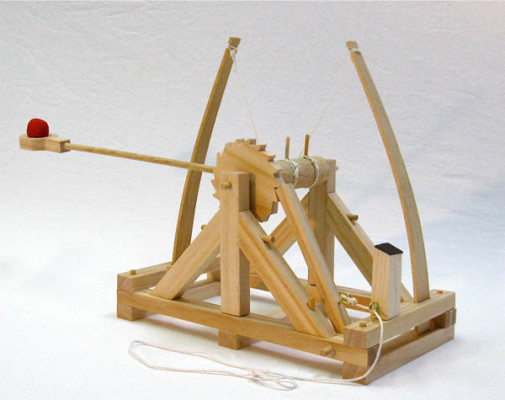We use cookies to make your experience better. To comply with the new e-Privacy directive, we need to ask for your consent to set the cookies. Learn more.
Leonardo da Vinci Catapult
10 x 16 x 5.5. Designed by the master inventor himself, this small-scale replica throws small objects (less than 1" diameter) up to 15 feet.
Leonardo made two drawings of catapults in the codex Atlanticus, dated somewhere in the 1480's. While gun powder had been invented well before this, he seemed to understand that it wasn't always reliable and that catapults still had a place in warfare. The da Vinci catapult took and interesting turn (as it were), since none were made like this before that have been documented. Da Vinci was often pitching to kings and local lords (to whom he was employed), new ideas to protect their castles and improve their effectiveness in battle.
He made two designs, a single arm and a double arm. Tension arms would have used a laminated wood of some kind, but the tension on them would have been huge.
On the single arm there was a long pole that inserted into the drum so the swing arm could be put into firing position. It used a ratchet system where as the arm was pushed into position, a ratchet would prevent it from firing. Once in position, the release mechanism was pulled.
The double arm catapult used a different winding mechanism. It essentially is a worm screw that would slowly wind a large wheel (improving leverage) that would move the swing arm into position. It would be engaged in the wheel, wound, then when in position, a release mechanism would be engaged to hold the tension.
The worm ear would be lowered so it was not engaged, and the release mechanism would be tripped and off goes the projectile! The tension must have been enormous, and it has never been discovered if either of these models were ever made or used in battle.
The main purpose of these all-natural, untreated wood kits is to demonstrate scientific principles in action. Heres how they work: each kit comes as a set of pre-cut wooden pieces, which are assembled according to illustrated black and white instructions. Once you finish putting everything together, the set becomes a fully-functional scientific or historical representation. The catapult, for example, stands at 8" tall, 5" wide, and can fling small objects over 15 feet. But its not just a glued-together wooden frame with a rubber band attached; these kits are put together almost precisely how the real thing was, using only authentic parts. Small wooden pegs (miniature versions of the huge pegs used in the real deal) connect crossbars, supports, and pieces of the frame just as nails would in modern-day building projects. A tiny rope strung through the middle and wound by torsion bars gives the catapult its power, allowing it to hurl miniature stand-ins such as fruit, marshmallows, or even tiny rocks in the exact same way several-hundred-pound projectiles were once thrown in medieval times.
The attention to detail and precise engineering of these kits is absolutely wonderful. While this level of complexity increases the time it takes to put together these kits (about 1 to 2 hours), it also drastically improves the functionality and realism. Kids can learn not only how modern and medieval inventions were put together, but they can also see the scientific principles in action that make them work. The creator of these kits even suggests combining the medieval siege weapons with math and physics lessons to learn about trajectories and graphing. The hydraulics-powered Robotic Arm is a great example of a scientific principle in action. Using three different syringes on a control panel of sorts, the arm can be used to move up and down, turn, and grab objects between two foam panels.
All kits are fully interactive. Catapults and trebuchets throw things, bridges can turn and lift using cranks and other wooden controls, and hydraulic machines can be controlled by liquid-filled syringes. These kits are also made to be supplemented with other toys; kids can use LEGO figures or other toys to man siege engines or operate bridge controls as a miniature train or other vehicle starts to cross. For more advanced builders and artists, all kits can be painted piece-by-piece to look even better.












Reviews were good and it was affordable
medieval studies
Made one before
creative, fun physical game